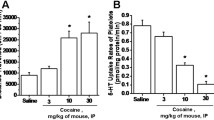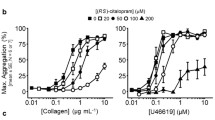Summary
The 5-HT2-receptor antagonist ketanserin (20–40 mg b.i.d.) was administered to 62 patients of both sexes with uncomplicated primary hypertension. After 4 weeks of treatment about 50% of the patients had reached the target diastolic blood pressure of 90 mm Hg or below. Interindividual variability was large. In a retrospective analysis the variability could not be explained by sex or the dose of ketanserin. There was a weak association between age and systolic blood pressure response (r=0,24; P=0.06), which could be entirely accounted for by the higher base line blood pressure in the elderly patients.
In one group of patients (n=12), the ex vivo aggregation to serotonin (10−6 M) was studied during treatment with placebo and ketanserin. Ketanserin completely inhibited 5-HT-induced aggregation in all patients. There was a close correlation between the area under the 5-HT-induced platelet aggregation curve during placebo and the subsequent reduction in diastolic blood pressure after 4 weeks of treatment with ketanserin.
The present data suggest that the blood pressure response to ketanserin can be predicted from the ex vivo sensitivity of platelets to serotonin. By implication, they also support a role for serotonergic mechanisms in hypertension.
Similar content being viewed by others
References
Poplawski A, Skorulska M, Micwiarowski S (1968) Increased platelet adhesiveness in hypertensive cardiovascular disease. J Atheroscler Res 8: 721–723
Cocceri S, Fiorentini P (1971) Platelet adhesiveness and aggregation in hypertensive patients. Acta Med Scand Suppl 525: 273–275
Mehta J, Mehta P (1981) Platelet function in hypertension and effect of therapy. Am J Cardiol 47: 331–334
Kjeldsen SE, Gjesdal K, Eide I, Aakesson I, Amundsen R, Foss OP, Leren P (1983) Increased beta-thromboglobulin in essential hypertension; interactions between arterial plasma adrenaline, platelet function and blood lipids. Acta Med Scand 214: 369–373
Fetkovska N, Amstein R, Ferracin F, Regenass M, Buhler FR, Pletscher A (1990) 5-Hydroxytryptamine kinetics and activation of blood platelets in patients with essential hypertension. Hypertension 15: 267–273
De Clerck F, Van Neuten JM, Reneman RS (1984) Platelet vessel wall interactions: Implications of 5-hydroxytryptamine. A review. Agents and Actions 15: 612–626
Vanhoutte PM (1991) Platelet-derived serotonin, the endothelium and cardiovascular disease J Cradiovasc Pharmacol 17 [Suppl 5]: S6-S12
Van Nueten JM, Janssens WJ (1986) Augmentation of vasoconstrictor responses to by acute and chronic factors: inhibition by ketanserin. J Hypertens 4 [Suppl 1]: S55-S59
Doyle AE, Fraser JRE, Marshall RJ (1959) Reactivity of forearm vessels to vasoconstrictor substances in hypertensive and normotensive subjects. Clin Sci 18: 441–454
Webb RC, Vanhoutte PM (1985) Responsiveness of the hypertensive blood vessel wall to serotonergic stimuli. In: Vanhoutte PM (ed) Serotonin and the cardiovascular system. Raven Press, New York; pp 113–121
DeClerck F, David J-L, Janssen PAJ (1982) Inhibition of 5-hydroxytryptamine-induced and amplified platelet aggregation by ketanserin (R 41468), a selective 5-HT2-receptor antagonist. Agents Actions 12: 388–397
Hedner T, Persson B, Berglund G (1984) Ketanserin, a novel 5-hydrosytryptamine antagonist; monotherapy in essential hypertension. Br J Clin Pharmacol 16: 121–125
Persson B, Pettersson A, Hedner T (1987) Pharmacokinetics of ketanserin in patients with essential hypertension. Eur J Clin Pharmacol 32: 259–265
Hedner T, Pettersson A, Persson B (1987) Chronic 5-HT2 receptor blockade by ritanserin does not reduce the blood pressure in patients with essential hypertension. Acta Med Scand 222: 307–310
Nyberg G (1977) Indirect blood pressure and heart rate measured quickly without observer bias using a semiautomatic machine (Auto-Manometer) — response to isometric exercise in normally healthy males and its modification by b-receptor blockade. Br J Clin Pharmacol 4: 275–281
Winther K, Knudsen JB, Gormsen J, Jensen J (1986) Effect of metoprolol and propranolol on platelet aggregation and cAMP level in hypertensive patients. Eur J Clin Pharmacol 29: 1561–1564
Born GVR (1962) Aggregation of blood platelets by adenosine diphosphate and its reversal. Nature 194: 1927–1929
Brunner HR, Menard J, Waeber B, Burnier M, Brollaz J, Nussberger J, Belet M (1990) Treating the individual antihypertensive patient: considerations on dose, sequential monotherapy and drug combinations. J Hypertens 8: 3–13
Doyle AE (1991) Age-related effects of 5-HT2 antagonists. J Cardiovasc Pharmacol 17 [Suppl 5]: S29-S34
Persson B, Heykants J, Hedner T (1991) Clinical pharmacokinetics of ketanserin. Clin Pharmacokin 20: 263–279
DeCree J, Hoing M, de Ryck M, Symoens J (1985) The acute antihypertensive effect of ketanserin increases with age. J Cardiovasc Pharmacol 7 [Suppl 7]: S126-S127
Cameron HA, Ramsay LE (1985) Ketanserin and essential hypertension; a double-blind, placebo-controlled study. Postgrad Med J 61: 583–586
Beretta-Piccoli C, Amstein R, Bertel O, Brunner HR (1987) Antihypertensive efficacy of ketanserin alone or in combination with a β-blocker or diuretic. J Cardiovasc Pharmacol 10 [Suppl 2]: S107-S112
Breckenridge A (1988) Ageing, serotonin and ketanserin. Drugs 36 [Suppl 1]: 44–54
Elliot HL (1988) α1-adrenoceptor responsiveness: influence of age. J Cardiovasc Pharmacol 12 [Suppl 8]: S116-S120
Murray GD, Lesaffre E (1988) Statistical pitfalls in the analysis of age-related effects in antihypertensive therapy. J Cardiovasc Pharmacol 12 [Suppl 8]: S167-S172
Rosendorff C, Murray GD (1986) Ketanserin versus metoprolol and hydrochlorothiazide (HCTZ) in essential hypertension: only ketanserin's hypotensive effect is age-related. J Hypertens 4 [Suppl 6]: S109-S111
De Crée J, Leempoels J, Demoen B, Roels V, Verhagen H (1985) The effect of ketanserin, a 5-HT2-receptor antagonist, on 5-hydroxytryptamine-induced irreversible platelet aggregation in patients with cardiovascular disease. Agents Actions 16: 313–317
Mills DCB, Mac Farlene DE (1976) Platelet receptors. In: Gordan JL (ed) Platelets in biology and pathology. Biomedical Press, Amsterdam; pp 159–202
Amstein R, Fetkovska N, Pletscher A, Bühler FR (1989) Platelet deactivation by 5-HT2-receptor blockade parallells the antihypertensive response to ketanserin. J Hypertens 7: 255–260
Fetkovska N, Amstein R, Ferracini R, Regenass M, Buhler FR, Pletscher A (1985) 5-HT kinetics and sensitivity of human blood platelets: variations with age, gender and platelet number. Thromb Haemost 60: 486–490
Gleerup G, Winther K (1988) The effect of ageing on human platelet sensitivity to serotonin. Eur J Clin Invest 18: 504–506
Vanhoutte PM, Amery A, Birkenhäger W, Breckenridge A, Bühler F, Distler A, Dormandy J, Doyle A, Frohlich E, Hansson L (1988) Serotonergic mechanisms in hypertension: focus on the effects of ketanserin. Hypertension 11: 111–133
Gradin K, Pettersson A, Hedner T, Persson B (1985) Chronic 5-HT2-receptor blockade with ritanserin does not reduce the blood pressure in the spontaneously hypertensive rat. J Neural Transm 64: 145–149
Pettersson A, Gradin K, Hedner T, Persson B (1985) Antihypertensive mechanisms of action of ketanserin and some ketanserin analogues in the spontaneously hypertensive rat. Naunyn Schmiedeberg's Arch Pharmacol 329: 394–397
Reimann IW, Frölich JC (1983) Mechanism of the antihypertensive action of ketanserin in man. BMJ 287: 381–383
Wenting GJ, Brouwer RML, Meiracker v.d. AJ, Man int't Veld AJ, Schalekamp MADH (1987) Mechanism of action of ketanserin in hypertension and vasospastic disease. Acta Cardiolog 42: 339–354
Gradin K, Pettersson A, Hedner T, Persson B (1985) Antihypertensive effects of ketanserin in the spontaneously hypertensive rat: mode of action. J Cardiovasc Pharmacol 7 [Suppl 7]: S110-S111
Van der Starre PJA, Reneman RS (1988) The α-adrenergic receptor blocking effect of ketanserin and the interaction between α-adrenergic and S2-serotonergic blockade. J Cardiovasc Pharmacol 11 [Suppl 1]: S54-S61
Author information
Authors and Affiliations
Rights and permissions
About this article
Cite this article
Gleerup, G., Persson, B., Hedner, T. et al. Serotonin-induced platelet aggregation predicts the antihypertensive response to serotonin receptor antagonists. Eur J Clin Pharmacol 44, 121–125 (1993). https://doi.org/10.1007/BF00315468
Received:
Accepted:
Issue Date:
DOI: https://doi.org/10.1007/BF00315468




